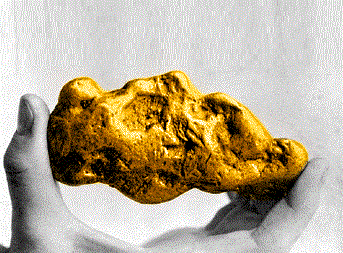The Cariboo region is an important source of both placer and lode gold in British Columbia. The placer gold is commonly found in rivers and creek with some of the richest creeks in Canada located within the region. Considerable gold is still being found there today.

Geology
The Lode deposits of the Cariboo are mainly gold rich pyritic quartz veins with a few bedded replacements. These two kinds of gold ore are related in their geology. Quite a number of gold deposits are found in the snowshoe and limestone bed formation although other thin limestone formations are also present.
Quartz vein gold deposits are widely distributed within the Cariboo region. A few of the veins are very large but the majority of the veins are small and closely spaced in some places. In most gold deposits the sulphide content is quite low however some have fairly large quantities of pyrite.
The replacement deposits are made up of mainly large fine grained pyrite which in places is replaced with rocks. Usually these deposits are covered in grey ankerite and sometimes the grey ankerite forms streaks within the deposit. There also quite a number of sulphide and siliceous replacement deposits. The shape of the replacement deposits largely depends on the host rock.
Within the Cariboo region the mineralization of both replacement and quartz gold deposit ores is relatively similar. Gold and silver which are often the major precious metals are mainly found in sulphide. Several other minerals such as cosalite, pyrrhotite, chalcopyrite, bismuthinite, arsenopyrite, sphalerite and scheelte also occur in the ores in miner quantities.
Also Read: Natural Gold Indicators (Part 1 of 3)
Widespread Gold Deposits
A number of gold discoveries had been recorded around this area in Quesnel Forks, Hills Bar, Antler Creek and Keithley Creek by 1860. The news of these discoveries on the Quesnel River and especially those of the Williams Creek discovery in 1862 brought in more miners to the Cariboo valley plateau which resulted in the now famous Cariboo gold rush. The years that followed was characterized by a swarm of miners occupying the region between Willow River and the Quesnel River. This was one of the richest gold areas in Canada at the time, and since then the Cariboo gold fields have been active producing hundreds of thousands of gold ounces each year.

Lightning Creek
One of the first places where gold was discovered in the Cariboo region is at Lightning Creek. The Creek feeds into the Swift River which flows through the Cariboo region. By mid-1870s the creek had attracted a number of gold mining companies along with thousands of individual miners. To date the total amount of gold extracted from the creek is estimated to be worth about $15,000,000.
Although most commercial mining stopped on the creek when the richest placers were depleted, there is a huge chance of getting gold if you go panning on the creek.
Keithley Creek
Another important gold mining creek in the Cariboo region is the famous Keithley Creek which drains into the western side of the Cariboo Lake. Gold was first discovered on the creek in 1860 before thousands of miners descended on it in an effort to become rich. Today, the Keithley Creek ghost town still stands at the site of the first discovery. Gold panners still find gold in the creek albeit in much smaller quantities when compared to what the gold rush day’s miners used to get.
Antler Creek
The Antler Creek is another great gold creek in the Cariboo region. Gold on the creek was discovered by John Rese in 1860. At its peak the creek used to produce about $10,000 worth of gold each day. Over the years, different mining methods such as hydraulic mining, sluicing, and drifting where used on the creek with Sawmill Flat being one of the gold richest areas.
Horsefly River
Horsefly River is another important source of gold in the Cariboo region. Small scale placer gold mining on the river began in the 1860’s before large operations where commenced much later. The mining activities on the river were in three major locations: the Miocene Shaft, the Ward’s Horsefly Mine and the Hebson’s Horsefly Mine. Today the river is still popular for gold panning.
Williams Creek
Williams Creek is one of the most historical gold creeks in the Cariboo region. The creek is located between the town of Wells and Barkerville and flows into the Willow River. Gold was first discovered on the creek by Wilhelm Dietz in 1862 and soon the creek become one of the most important mining center during the early days of the Cariboo gold rush. The creek was also home to a number of gold mining companies that operated well into the 20th century. Today the creek is provides a great place for gold panners to try their luck at finding real gold.
Next: Gold Mining Areas in Atlin, British Columbia
Gold Panning on the Fraser River







